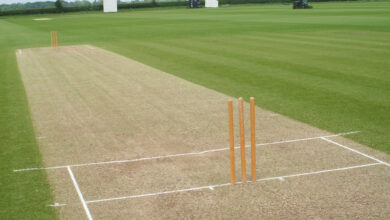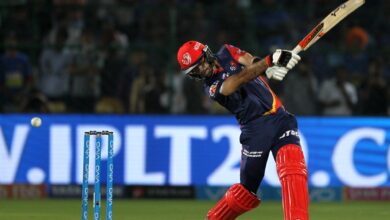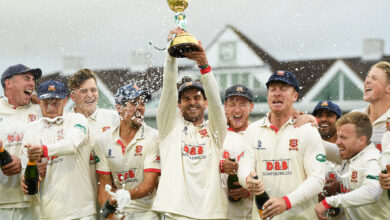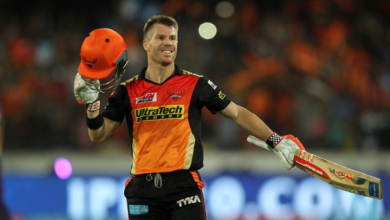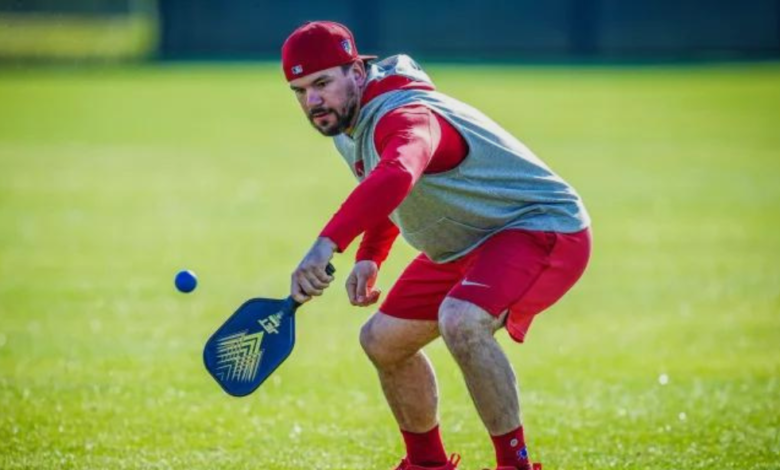
Philadelphia is experimenting by creating a brand-new sport called “Pacoball” to give spring training a fresh perspective.
When right fielder Nick Castellanos finally gives up, second baseman Bryson Stott has missed his third straight flyball. As they run and dive across a back field at spring training on Sunday, these four Philadelphia Phillies are drenched in perspiration as they prepare for what they hope would be a third consecutive postseason appearance. The morning is still cold. But their gloves and bats are back in the clubhouse. All they have with them are six pickleball balls and pickleball paddles.
Castellanos calls upon Stott’s double-play partner. Trea Turner would be furious at you if I were him. He makes chirps.
After Stott makes the following play, they go on to defeat Kyle Schwarber, the designated hitter, and Weston Wilson, the utility player. Castellanos congratulates Stott, saying, “Good boy.” “F—,” complains Schwarber.
They switch roles—center fielder Johan Rojas, who was officiating, replaces Wilson—and resume play. Someone asks when the players are meant to congregate so they may stretch at one point. “After this, do you need to stretch?” Castellanos trousers.
They all go back into the clubhouse to start what may be more conventionally thought of as baseball activities after Castellanos and Stott win round two. But according to outfield instructor Paco Figueroa, this modified pickleball—dubbed Pacoball, after Matt Gelb of The Athletic—is also.
According to Figueroa, “It helps with a lot of things.” “Agility, changing directions, dropping to get the ball, and going in to hit it are all necessary. I saw our three outfielders [playing opposite another three outfielders] exchanging places and a lot of “I got it, I got it” type communication. He grinned. And a great deal of it stems from rivalry. It is better the more you can compete.
For the third year running, pickleball has been the fastest-growing sport in the nation.
According to estimates made by the Association of Pickleball Professionals last year, 48.3 million adult Americans had played the hybrid game, which combines badminton, tennis, and ping-pong, at least once in the previous year. Figueroa is one of them; it was during the winter that he realized the links between his work and his passion.
This spring when he arrived at camp, he gave the grounds staff instructions to choose a spot where they could get out of the way and trample the grass before demarcating four thirty-foot-by-thirty-foot squares. After playing a few practice games with the staff (catcher Garrett Stubbs describes it as “a combination of foursquare, squash, and pickleball”), he gave his outfielders a lesson in the modified game.
Jake Cave, a corner outfielder, states, “I’ve never played pickleball.” “And a few days ago, I was making fun of it, saying that it was like a game for old people because my dad lives in The Villages, which describes itself as ‘Florida’s friendliest active adult 55+ retirement community,’ and that’s the most played game there,” I was joking around with it. But I walked outside after that. Cave promises to apologize over the phone to his father.

As Figueroa selects new features to highlight, the rules shift. Since racquetballs are tougher and don’t have nets, they are used instead of wiffleballs. The main reason players utilize their nondominant hands is to train to utilize their glove hand, but they also use them to avoid smashing balls so hard that they kill a teammate.
Figueroa recently made the decision that, if both players communicate, a player may lob the ball to his teammate on a difficult play, who would then hit it to the opposition. (But no prefabricated parts.) Figueroa eventually intends to maintain records both by the team and by an individual player. He is far behind the players: Cristian Pache, a center fielder, is already keeping note of statistics. By coincidence, Pache is listed as the most successful player in those stats.
While Castellanos receives accolades from teammates, Pache receives a lot of votes for best player. He isn’t certain. Which player is the best?
It’s too soon to tell, he replies.
Who is the worst?
It’s too soon to tell.
Still, it’s not too soon to call his outfield performance a crossover. He admits, “Sometimes I make some outstanding plays.” “But then there are other times when I make dumb mistakes, like forgetting to let it bounce the second time.” He grinned and said, “All my mistakes are stupid and losing focus, just like in baseball.” However, I occasionally flash the paddle.
Even by himself, Schwarber is universally regarded as the worst player, which he claims drives him insane because he excels at ordinary pickleball. It’s helpful to know that I’m not particularly coordinated with my off-hand, he admits. (In fact, Schwarber is far more competitive when they momentarily switch to using their dominant hands.)
Figueroa is a firm believer in the advantages of confidence and agility. He calls the space just around an outfield player “the five-foot circle,” occasionally drawing one on the ground, and yells at them to leave the circle as soon as they can. He works with outfielders on a half-sized field during the first two weeks of spring training, bringing them in toward the infield and cutting down on their amount of time to react to the ball off the bat.
They receive ground balls in the same manner as regular infielders, bending down a few feet away and working their way back. The game feels slower when they finally reach full distance. Additionally, he states that he puts “guys that are panicking with a ground ball” back on their knees and restarts.
As you can see, the finest defenders are aggressive with the ball, and that’s what I prefer to teach. “You can picture it. Those who lack confidence tend to lose it early on due to their anxiety about making a mistake. They then stiffen their shoulders and withdraw. Many persons with good hands are also skilled players of ping-pong. He gives an example of how having tight follow-through and rapid wrist movement may aid in ball scooping. He states, “That little move is a confident move; it doesn’t have to be an aggressive one.” Thus, it is essentially what you are producing. You will be running and suddenly it will be like, Oh sh*t. Act aggressively while you’re feeling down.
(On a different field, Bobby Dickerson, the infield coach, is teaching his infielders how to play like outfielders by adding a few pop-ups behind ground balls to round off each day’s practice. “He discusses it, saying that you’re a 360-degree player rather than a 180-degree player,” according to Figueroa.)
As an infielder, Stott is not officially invited to the sessions, but he decided to attend them on Sunday because he felt they looked like fun. He also intends to ask Turner to join him. Stott downplays the notion that he is not technically proficient, focusing instead on his winning heart.
To which Stott responds, “I won two games.” “This is the first day for me. They have been engaged in three weeks of play.
Okay, so what is his report on his reconnaissance of the remaining ones? Who is the greatest, in his opinion?
He states, “I’m not sure if any of them are good.” “Every game that Trea and I play, we will win. You’ll discover.

